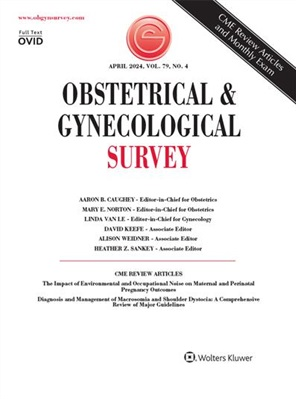The Predictive Value of Prenatal Cell-Free DNA Testing for Rare Autosomal Trisomies: A Systematic Review and Meta-analysis
IF 3.6
4区 医学
Q1 OBSTETRICS & GYNECOLOGY
引用次数: 0
Abstract
ABSTRACT Noninvasive prenatal testing has been a reliable method for prenatal screening for the common autosomal trisomies for the last decade. It has been analyzed in many prospective studies for accuracy in screening for the most common trisomies—13, 18, and 21—and the technology has continued to progress. With high accuracy for common trisomies, advances are attempting to expand noninvasive prenatal testing for identifying rare autosomal trisomies, such as trisomies 7, 15, 16, and 22; sex chromosome aneuploidies; and segmental copy number variants. Although cell-free DNA (cfDNA) technology is now available to screen for these abnormalities, accuracy and detection rates have not been well studied. This systematic review analyzes and reports the diagnostic accuracy of cfDNA screening for the rare autosomal trisomies. This review included case series with 10 or more cases that reported on the accuracy of cfDNA in reporting rare autosomal trisomies that were confirmed by diagnostic results or postnatal genetic testing; the final review included 31 studies. Methodological analysis found the risk of bias to be high in most studies, with only 5 rated as high quality and low risk in all domains. All studies included in the final analyses were published between 2017 and 2022, and study populations ranged from 14 to 153,575 patients. Indications for screening and characteristics of the patients varied from study to study, with 12 studies in high-risk women, 10 studies in the general obstetric population, and 9 studies without inclusion of underlying risk factors and indications. Whole-genome sequencing was used in all studies as testing methodology. Testing timing varied and was performed anywhere from gestational week 8 to week 39. In the 3 studies that analyzed sensitivity and specificity of cfDNA testing, sensitivity ranged from 87.2% to 100%, and specificity ranged from 90.7% to 99.9%. In all 3 of these studies, there were significant limitations that led authors to acknowledge the difficulty of drawing clear conclusions about sensitivity and specificity from their data. Meta-analysis performed for positive predictive value (PPV) provided a pooled estimate of 11.46% (95% confidence interval [CI], 7.80%–15.65%). Sensitivity analysis including only studies at low risk of bias gave a PPV of 9.13% (95% CI, 2.49%–18.76%). Analysis was performed again with groups divided into high or low background risk, with a slightly higher PPV in the higher background risk group, but no significant difference between these groups ( P = 0.595). Statistical heterogeneity was not explained by year of publication or baseline risk of participants but could be largely explained by rate of diagnostic follow-up. Studies with a follow-up rate of less than 50% showed a PPV of 23.69% (95% CI, 9.21%–41.94%), whereas studies with a follow-up rate greater than 50% reported a PPV of 8.80% (95% CI, 6.08%–11.90%). Based on the results of this systematic review and meta-analysis, it is likely that previously reported PPVs of cfDNA's diagnostic accuracy for detecting rare autosomal trisomies are overestimated. A reason for this could be lower follow-up rates as well as testing bias in women with high-risk cfDNA results. One reason for the low prevalence of rare autosomal trisomies is that many confirmed cases result in miscarriage before 12 weeks of gestation. Pregnancies that continue and that are not mosaic often experience major complications. The occurrence of mosaicism may impact the PPV, as mosaicism carries some risks but is sometimes not detected from cfDNA samples. This study was limited by the details included in the studies analyzed; this caused significant statistical heterogeneity, which limits the conclusions that can be drawn. In addition, detection rates may differ by type of cfDNA test, and this analysis did not stratify by type of test. The results of this analysis are consistent with previous literature on detection of rare autosomal trisomies in the general population and show that even with a high specificity and sensitivity for cfDNA testing in general, care should be taken in making clinical decisions on the part of both providers and patients in instances where a rare autosomal trisomy is suspected.产前无细胞DNA检测对罕见常染色体三体的预测价值:一项系统综述和荟萃分析
在过去的十年中,无创产前检查一直是一种可靠的产前筛查常见常染色体三体的方法。在许多前瞻性研究中,它已经被分析用于筛选最常见的三体- 13、18和21 -的准确性,而且这项技术还在继续进步。随着对常见三体的高精度检测,非侵入性产前检测正在扩大,以识别罕见的常染色体三体,如7、15、16和22三体;性染色体非整倍体;和分段拷贝数变体。尽管无细胞DNA (cfDNA)技术现在可用于筛查这些异常,但准确性和检出率尚未得到很好的研究。本系统综述分析并报道了cfDNA筛查对罕见常染色体三体的诊断准确性。本综述纳入了10例或10例以上病例的病例系列,这些病例报告了cfDNA在报告罕见常染色体三体时的准确性,这些病例被诊断结果或出生后基因检测证实;最终的综述包括31项研究。方法学分析发现,大多数研究的偏倚风险较高,只有5项研究在所有领域被评为高质量和低风险。最终分析中包括的所有研究都是在2017年至2022年之间发表的,研究人群从14到153575名患者不等。筛查的适应症和患者的特征因研究而异,其中12项研究针对高危妇女,10项研究针对普通产科人群,9项研究未纳入潜在危险因素和适应症。所有研究均采用全基因组测序作为检测方法。测试时间各不相同,从妊娠第8周到第39周进行。在分析cfDNA检测敏感性和特异性的3项研究中,敏感性范围为87.2% ~ 100%,特异性范围为90.7% ~ 99.9%。在所有这3项研究中,有明显的局限性,使作者承认很难从他们的数据中得出关于敏感性和特异性的明确结论。对阳性预测值(PPV)进行meta分析,汇总估计为11.46%(95%置信区间[CI], 7.80%-15.65%)。仅包括低偏倚风险研究的敏感性分析得出PPV为9.13% (95% CI, 2.49%-18.76%)。再次进行分析,分为高背景风险组和低背景风险组,高背景风险组PPV略高,但两组间无显著差异(P = 0.595)。统计异质性不能用发表年份或参与者的基线风险来解释,但在很大程度上可以用诊断随访率来解释。随访率小于50%的研究显示PPV为23.69% (95% CI, 9.21%-41.94%),而随访率大于50%的研究报告PPV为8.80% (95% CI, 6.08%-11.90%)。基于本系统综述和荟萃分析的结果,以前报道的cfDNA检测罕见常染色体三体的诊断准确性ppv可能被高估了。造成这种情况的原因可能是随访率较低,以及在cfDNA结果较高的女性中存在检测偏差。罕见常染色体三体发病率低的一个原因是,许多确诊病例在妊娠12周之前导致流产。持续妊娠和非镶嵌妊娠通常会经历严重的并发症。镶嵌现象的发生可能会影响PPV,因为镶嵌现象具有一定的风险,但有时无法从cfDNA样本中检测到。本研究受限于所分析研究的细节;这导致了显著的统计异质性,限制了可以得出的结论。此外,检出率可能因cfDNA检测类型而异,本分析未按检测类型分层。本分析结果与以往关于在普通人群中检测罕见常染色体三体的文献一致,并表明即使cfDNA检测在一般情况下具有高特异性和敏感性,但在怀疑罕见常染色体三体的情况下,提供者和患者在做出临床决定时都应谨慎。
本文章由计算机程序翻译,如有差异,请以英文原文为准。
求助全文
约1分钟内获得全文
求助全文
来源期刊
CiteScore
2.70
自引率
3.20%
发文量
245
审稿时长
>12 weeks
期刊介绍:
Each monthly issue of Obstetrical & Gynecological Survey presents summaries of the most timely and clinically relevant research being published worldwide. These concise, easy-to-read summaries provide expert insight into how to apply the latest research to patient care. The accompanying editorial commentary puts the studies into perspective and supplies authoritative guidance. The result is a valuable, time-saving resource for busy clinicians.

 求助内容:
求助内容: 应助结果提醒方式:
应助结果提醒方式:


